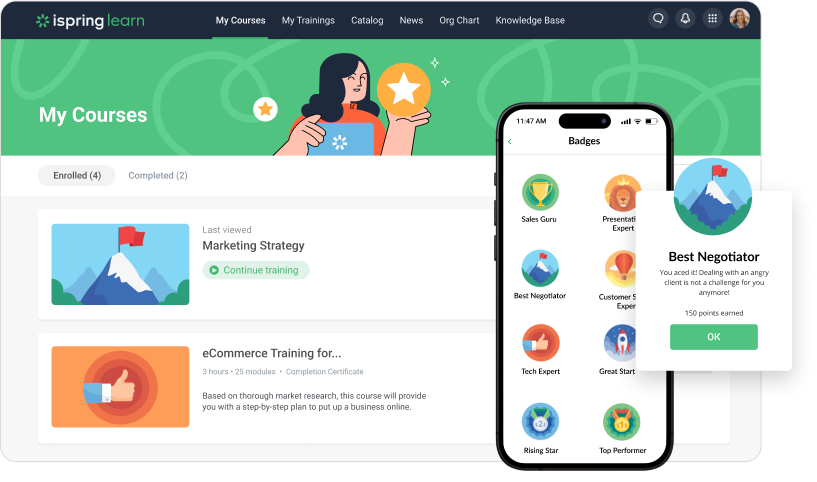HRMS vs LMS? Hidden Benefits and Trade-Offs

“Our HRMS already has a learning module; do we actually need to invest in a standalone LMS?”
If you’re responsible for employee training, you’ve probably faced this HRMS vs LMS dilemma. On the surface, the answer seems straightforward — fewer tools, fewer headaches. But when you dig a little deeper, it gets more complicated.
To avoid frustration, we spoke with Alexander Salas, a certified T&D professional and technical trainer, and the iSpring L&D team to take an honest look at both options. In this article, we’ll explore their practical realities: the genuine benefits, overlooked limitations, and when each choice makes sense.
What Is an HRMS with an LMS Module?
An HRMS (human resource management system) is a platform designed to manage the entire employee lifecycle — from hiring and onboarding to payroll, performance management, and other HR processes.
When we say “an HRMS with an LMS module,” we mean that the platform also offers basic functionality for employee training, typically as one additional tool among many others. HR LMS usually covers the essentials:
- Uploading and assigning training materials like documents, presentations, or videos.
- Tracking employees’ progress with general training reports.
- Managing basic certifications within employee profiles.
In short, an HR LMS is designed primarily for convenience by integrating learning into your general HR workflows.
The key benefits of HRMS with a built-in LMS
Here are some practical benefits that companies typically encounter with an HR learning management system:

Lower initial costs
The learning management system’s functionality typically comes bundled as part of your existing HR platform or as an affordable add-on. If your corporate training requirements are modest (mostly standard onboarding, occasional compliance training, or distributing basic internal documentation), this built-in approach is financially attractive.
Centralized database and user management
When training is integrated directly into your HR management system, all employee data lives under one roof. With an LMS in HR solution, you can easily track who completed mandatory training, verify compliance status, and even connect training records directly with employee performance management or professional development plans.
Faster deployment for small teams
For smaller companies or teams without dedicated L&D (learning and development) specialists, LMS in an HR tool can significantly accelerate training rollout. The built-in solution typically requires minimal setup or customization, enabling your human resource or administrative staff to quickly upload existing learning content and immediately assign it to employees.
Single vendor relationship
One vendor means fewer contracts to manage and simplified support interactions. Since you’re already familiar with your HR vendor, communication channels are clear, and any issues can be resolved through the existing support structure.
The Obvious Drawbacks of an HRMS with an LMS
Of course, convenience often comes at the expense of capability. Here’s Alexander Salas’ take on why companies initially choose an HRMS integration with an LMS module instead of a dedicated LMS:
“More often than not, enterprise organizations are “sold into” an HRMS built-in LMS rather than choosing it. The problem with HRMS-based LMS products is that they are often not a complete solution, or they are usually an afterthought of HRMS vendors. It is possible to achieve a highly integrated learning experience this way, but the tech and overhaul costs are often astronomical.”
When you rely solely on the LMS module within an HRMS, certain limitations start to become apparent as your training needs grow or evolve:

Limited training variability
Typically, HR tools with built-in LMS modules only support basic scenarios, such as assigning mandatory compliance courses or basic onboarding programs. However, if your organization needs advanced learning options like on-the-job training, complex blended learning experiences, cohort-based courses, or adaptive learning paths for future succession planning, you’ll quickly hit a wall.
This restricts your LMS use cases to only the most basic scenarios, greatly limiting your ability to vary talent development methods.
Poor learner experience
HRMS-based LMS modules tend to prioritize administrative convenience over learner experience. Often, interfaces are designed primarily for admins or HR professionals — not for learners seeking engaging, intuitive interactions. This can lead to frustration, disengagement, and low course completion rates.
Lack of advanced analytics
Most integrated LMS modules provide only basic training reports, such as completion percentages or overdue courses. If you want deeper insights into training effectiveness, skill development, learner behavior, or predictive analytics, an HRMS-based LMS rarely delivers, making it harder to measure ROI or improve your learning strategy over time.

Basically no content authoring
HR platforms with built-in LMS modules typically don’t include content creation tools. That means you’ll either need separate authoring software or settle for less engaging content formats. Such a lack of functionality can significantly limit creativity and learning effectiveness.
Learning innovation lag
An LMS that’s simply one of many HR system features won’t evolve as quickly as a dedicated LMS platform. As a result, you could quickly find your L&D strategy stuck in the past, limiting your organization’s ability to adopt modern approaches to employee learning.
What You Get with a Standalone LMS
A standalone learning management system (LMS) is a dedicated platform that’s specifically designed to handle all aspects of employee training and development. Unlike an LMS module within an HRMS, standalone learning management systems put learning at the center, offering comprehensive tools to create, deliver, manage, and measure training effectively.
Advantages of a standalone LMS
Standalone learning management systems allow you to elevate training from a basic administrative task to a strategic asset that actively contributes to employee growth and organizational success. Let’s look closer at the specific advantages:

Enhanced learner experience
A standalone LMS places learners at the heart of the experience, offering a user-friendly and engaging training environment. Mobile-friendly access, personalized learning dashboards, and gamification help establish learning habits and enhance completion results.

Stronger analytics and customization
With a standalone LMS, you track training from every angle, not just basic training completions. For example, iSpring Learn provides more than 25 comprehensive reports that cover individual, team, and departmental progress, along with valuable insights into which content resonates and which raises questions.
Additionally, dedicated learning management systems let you create customized reports that directly tie learning outcomes to business objectives. This allows you to continuously optimize training programs and clearly demonstrate a measurable impact to stakeholders.
Also read:



Scalability with business growth
Whether your organization is expanding rapidly, introducing new training programs, or starting to train external partners or customers, a standalone LMS adapts easily. This scalability ensures that your learning platform won’t become a roadblock but actively supports your company’s ambitions and future training strategies.
Rapid innovation and regular updates
Finally, providers that specialize exclusively in learning platforms continuously invest in their LMS products and introduce new features aligned with current trends and customer feedback.
For instance, in 2024 alone, iSpring Learn rolled out over 70 new features and updates, consistently expanding and enhancing both admin and user experience.
The limitations of a standalone LMS
Let’s realistically evaluate some challenges associated with implementing a dedicated LMS:

Potentially higher initial investment
A standalone LMS usually involves higher upfront costs (licensing, implementation, and integration) compared to an LMS module that’s included in your human capital management platform.
Ensure that stakeholders perceive the long-term LMS ROI by demonstrating specific business impacts, like improved training outcomes, reduced turnover, or enhanced productivity.
Additional platform management
Managing an extra platform adds administrative complexity. To minimize overhead and streamline training, prioritize LMS solutions that offer robust automation of learning processes and smooth integrations with your existing tech ecosystem.
Risk of underutilization
There’s always a risk of investing in advanced features like social learning or performance evaluation that remain unused if training isn’t strategically aligned or consistently promoted internally. Consider choosing an LMS with modular pricing or flexible active user-based billing to better align costs with actual platform usage.
HRMS vs LMS: Which Is Better for Your Business?
To be fair, there’s a time and place for both solutions. For smaller businesses or teams just starting with training, an LMS module within your HRMS system might be enough. It covers the basics, keeps things centralized, and gets the job done for occasional compliance or an onboarding process.
But as your organization grows, so do your training needs. As soon as you start building structured onboarding, launching development tracks, or supporting multiple roles and regions, you’ll likely outgrow the limited functionality of an HRMS-based LMS (often sooner than expected.)

When comparing HRMS vs LMS, a separate LMS gives you room to grow, offering purpose-built tools and the flexibility to support advanced training scenarios at scale.
Ideally, a standalone LMS and your HRMS should work in tandem through an LMS integration:

Platforms like iSpring Learn offer HRMS integration with popular systems like Bamboo HR, OrangeHRM, and PeopleWeek, so your online training stays aligned with employee records, organizational structure, and reporting needs. With the right HRMS integration, you can:
- Automatically sync users, roles, and departments
- Trigger training based on HR events like new hires or promotions
- Clear data management for accurate reporting and compliance
- Reduce manual work for both HR and L&D teams

For large enterprises, the decision may look different again. In these cases, a fully customizable learning environment is also a valid path if your business model and training strategy demand it.
Alexander Salas suggests asking a few practical questions before committing to either option:
 Alexander Salas, Certified T&D professional, ID, and technical trainer
Alexander Salas, Certified T&D professional, ID, and technical trainer1. Will you be able to afford the needed “modules” of the HRMS? This will be very expensive, but having the HR, Learning, and Performance Analytic modules in one fully integrated tool can be an automation advantage.
2. How much administrative control do you need in the LMS? The bigger the system, i.e., HRMS, the more often you would see red tape or slow access to make needed changes quickly. If you need to have MORE control, the best option is a standalone LMS.
3. Pay close attention to the vendor’s “sales workflow.” For example, can you get your hands on the software before spending hours listening to sales pitches? Many standalone LMSs are great at offering free trials.
Wrapping Up: A Quick Self-Check on HRMS vs LMS
To help you make an informed decision between HRMS vs LMS based on where your business priorities and training needs are right now, we’ve put together a quick self-check. Answer these four questions — each response marked “2” gives you 2 points, while “1” gives you 1 point.

1. Occasionally (a few times a year, mostly compliance or onboarding).
2. Continuously (onboarding employees, upskilling, cross-training, role-specific learning).

1. We just need to assign and track basic courses.
2. We want to build a learning culture, enhance the team’s competencies, or train external audiences.

1. No.
2. Yes.

1. No major changes are planned.
2. Yes, we plan to scale hiring, launch new programs, or expand audiences (e.g., train different departments).
Now total your points:
- 1-4 points. An LMS module within your talent management system is probably sufficient for now. You’re keeping training simple, and that’s fine, especially if your needs are basic and stable.
- 5 points. You’re approaching the limits of what an HRMS-based LMS can offer. Start exploring dedicated LMS options that can grow with you, and make sure they integrate well with your HR system.
- 6–8 points. You’re ready for a standalone LMS. You have strategic organizational goals and growing needs and require more flexibility. A dedicated learning management platform will give you the tools, scale, and reporting depth to support long-term training initiatives.
If you aren’t sure where to start and want expert advice, don’t hesitate to book a free consultation with an iSpring eLearning manager to discuss your training needs and see how the iSpring Learn LMS can support them.







